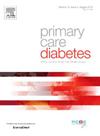Impact of general practitioner appointment frequency on disease management in type 2 diabetes mellitus patients
IF 2.6
4区 医学
Q3 ENDOCRINOLOGY & METABOLISM
引用次数: 0
Abstract
Aims
We investigated the association between the frequency of visits to general practitioners (GPs) and the degree of disease control in patients with T2DM.
Methods
This study included patients diagnosed with T2DM who visited their GPs between 2014 and 2018. A total of 89,674 patients, accounting for 1,203,035 visits, were included. Different clinical features such as glycated hemoglobin (HbA1c%), blood pressure (BP), and c-LDL levels were analyzed. Multifactorial control of T2DM was defined as HbA1c ≤ 7 %, BP ≤ 140/90 mmHg, and LDL cholesterol ≤ 100 mg/dL. Generalized Estimating Equations models were implemented in order to deal with repeated measures for the same patient.
Results
The median age of the patients is 70 years, with 52.8 % being male. An increase in the number of visits per year significantly improves the likelihood of achieving multifactorial diabetes control. Patients with more than 3-visits per year (55.6 %) have a Relative Risks (RR) of 1.258 (95 % Confidence Interval: 1.120–1.414). Frequent visits are associated with better multifactorial control and better c-LDL management. Patients visiting more than 3-times annually tend to achieve better outcomes in multifactorial and c-LDL control.
Conclusion
Increasing the frequency of primary care visits significantly enhances multifactorial and cholesterol control among T2DM patients.
全科医生预约频率对2型糖尿病患者疾病管理的影响
目的:研究T2DM患者全科医生就诊频率与疾病控制程度之间的关系。方法:本研究纳入了2014年至2018年间就诊的T2DM患者。共纳入89,674名患者,就诊次数为1,203,035次。分析不同的临床特征,如糖化血红蛋白(HbA1c%)、血压(BP)和c-LDL水平。T2DM多因素控制定义为HbA1c≤ 7 %,BP≤ 140/90 mmHg, LDL胆固醇≤ 100 mg/dL。为了处理同一患者的重复测量,实现了广义估计方程模型。结果:患者中位年龄70岁,男性52.8 %。每年就诊次数的增加可显著提高实现多因素糖尿病控制的可能性。每年就诊超过3次的患者(55.6% %)的相对危险度(RR)为1.258(95% %可信区间:1.120-1.414)。频繁就诊与更好的多因素控制和更好的c-LDL管理相关。每年就诊3次以上的患者往往在多因素和c-LDL控制方面取得更好的结果。结论:增加初级保健就诊频率可显著提高T2DM患者多因素及胆固醇控制水平。
本文章由计算机程序翻译,如有差异,请以英文原文为准。
求助全文
约1分钟内获得全文
求助全文
来源期刊

Primary Care Diabetes
ENDOCRINOLOGY & METABOLISM-PRIMARY HEALTH CARE
CiteScore
5.00
自引率
3.40%
发文量
134
审稿时长
47 days
期刊介绍:
The journal publishes original research articles and high quality reviews in the fields of clinical care, diabetes education, nutrition, health services, psychosocial research and epidemiology and other areas as far as is relevant for diabetology in a primary-care setting. The purpose of the journal is to encourage interdisciplinary research and discussion between all those who are involved in primary diabetes care on an international level. The Journal also publishes news and articles concerning the policies and activities of Primary Care Diabetes Europe and reflects the society''s aim of improving the care for people with diabetes mellitus within the primary-care setting.
 求助内容:
求助内容: 应助结果提醒方式:
应助结果提醒方式:


